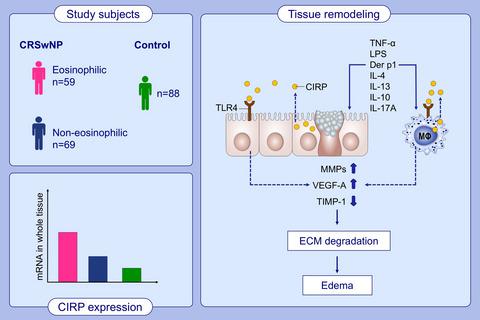Our official English website, www.x-mol.net, welcomes your
feedback! (Note: you will need to create a separate account there.)
Cold-inducible RNA-binding protein contributes to tissue remodeling in chronic rhinosinusitis with nasal polyps
Allergy ( IF 12.6 ) Pub Date : 2020-04-06 , DOI: 10.1111/all.14287 Li-Li Shi 1 , Jin Ma 1 , Yi-Ke Deng 1 , Cai-Ling Chen 1 , Heng Wang 1 , Ping-Ping Cao 1 , Xiao-Bo Long 1 , Ming Zeng 1 , Zheng Liu 1
Allergy ( IF 12.6 ) Pub Date : 2020-04-06 , DOI: 10.1111/all.14287 Li-Li Shi 1 , Jin Ma 1 , Yi-Ke Deng 1 , Cai-Ling Chen 1 , Heng Wang 1 , Ping-Ping Cao 1 , Xiao-Bo Long 1 , Ming Zeng 1 , Zheng Liu 1
Affiliation

|
BACKGROUND
Cold-inducible RNA-binding protein (CIRP) is a newly identified damage-associated molecular pattern molecule. Its roles beyond promoting inflammation and in human diseases are poorly understood. This study aimed to investigate the involvement of CIRP in chronic rhinosinusitis with nasal polyps (CRSwNP). METHODS
Immunohistochemistry, quantitative RT-PCR, and ELISA were used to detect the expression of CIRP and matrix metalloproteinases (MMPs) in sinonasal mucosal samples and nasal secretions. Human nasal epithelial cells (HNECs) and THP-1 cells, a human monocytic/macrophage cell line, were cultured to explore the regulation of CIRP and MMP expression. RESULTS
Cytoplasmic CIRP expression in nasal epithelial cells and CD68+ macrophages in sinonasal tissues, and CIRP levels in nasal secretions were significantly increased in both patients with eosinophilic and non-eosinophilic CRSwNP as compared to those in control subjects. IL-4, IL-13, IL-10, IL-17A, TNF-α, Dermatophagoides pteronyssinus group 1, and lipopolysaccharide induced the production and secretion of CIRP from HNECs and macrophages differentiated from THP-1 cells. CIRP promoted MMP2, MMP7, MMP9, MMP12, and vascular endothelial growth factor A (VEGF-A) production from HNECs, macrophages differentiated from THP-1 cells, and polyp tissues, which was inhibited by the blocking antibody for Toll-like receptor 4, but not advanced glycation end-products. The expression of MMPs and VEGF-A in tissues correlated with CIRP levels in nasal secretions in patients with CRSwNP. CONCLUSIONS
The upregulated production and release of CIRP from nasal epithelial cells and macrophages may contribute to the edema formation in both eosinophilic and non-eosinophilic CRSwNP by inducing MMP and VEGF-A production from epithelial cells and macrophages.
中文翻译:

冷诱导的 RNA 结合蛋白有助于慢性鼻窦炎鼻息肉的组织重塑
背景冷诱导RNA结合蛋白(CIRP)是一种新发现的损伤相关分子模式分子。除了促进炎症和人类疾病之外,人们对其作用知之甚少。本研究旨在调查 CIRP 在慢性鼻窦炎伴鼻息肉 (CRSwNP) 中的参与。方法采用免疫组化、定量RT-PCR和ELISA法检测鼻窦黏膜标本和鼻腔分泌物中CIRP和基质金属蛋白酶(MMPs)的表达。培养人鼻上皮细胞 (HNEC) 和人单核细胞/巨噬细胞系 THP-1 细胞以探索 CIRP 和 MMP 表达的调节。结果 鼻窦组织中鼻上皮细胞和 CD68+ 巨噬细胞中的细胞质 CIRP 表达,与对照组相比,嗜酸性粒细胞和非嗜酸性 CRSwNP 患者的鼻腔分泌物和 CIRP 水平均显着升高。IL-4、IL-13、IL-10、IL-17A、TNF-α、屋尘螨第 1 组和脂多糖诱导 HNEC 和 THP-1 细胞分化的巨噬细胞产生和分泌 CIRP。CIRP 促进 HNEC、THP-1 细胞分化的巨噬细胞和息肉组织产生 MMP2、MMP7、MMP9、MMP12 和血管内皮生长因子 A(VEGF-A),后者被 Toll 样受体 4 的阻断抗体抑制,但不是晚期糖基化终产物。CRSwNP患者组织中MMPs和VEGF-A的表达与鼻腔分泌物中CIRP水平相关。
更新日期:2020-04-06
中文翻译:

冷诱导的 RNA 结合蛋白有助于慢性鼻窦炎鼻息肉的组织重塑
背景冷诱导RNA结合蛋白(CIRP)是一种新发现的损伤相关分子模式分子。除了促进炎症和人类疾病之外,人们对其作用知之甚少。本研究旨在调查 CIRP 在慢性鼻窦炎伴鼻息肉 (CRSwNP) 中的参与。方法采用免疫组化、定量RT-PCR和ELISA法检测鼻窦黏膜标本和鼻腔分泌物中CIRP和基质金属蛋白酶(MMPs)的表达。培养人鼻上皮细胞 (HNEC) 和人单核细胞/巨噬细胞系 THP-1 细胞以探索 CIRP 和 MMP 表达的调节。结果 鼻窦组织中鼻上皮细胞和 CD68+ 巨噬细胞中的细胞质 CIRP 表达,与对照组相比,嗜酸性粒细胞和非嗜酸性 CRSwNP 患者的鼻腔分泌物和 CIRP 水平均显着升高。IL-4、IL-13、IL-10、IL-17A、TNF-α、屋尘螨第 1 组和脂多糖诱导 HNEC 和 THP-1 细胞分化的巨噬细胞产生和分泌 CIRP。CIRP 促进 HNEC、THP-1 细胞分化的巨噬细胞和息肉组织产生 MMP2、MMP7、MMP9、MMP12 和血管内皮生长因子 A(VEGF-A),后者被 Toll 样受体 4 的阻断抗体抑制,但不是晚期糖基化终产物。CRSwNP患者组织中MMPs和VEGF-A的表达与鼻腔分泌物中CIRP水平相关。











































 京公网安备 11010802027423号
京公网安备 11010802027423号